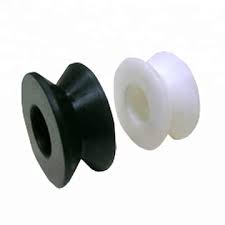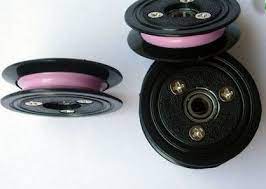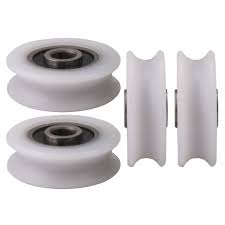Product Description
Customize Plastic wheel Polyurethane PU Roller Bearing
We can do as your size , color ,drawing, or samples.any needs, just contact us any time
| Product name | Plastic ball bearing wheels |
| ltem number | S323Z |
| Weight | 17g |
| Material | Nylon,PU |
| Color | White |
| Outline | White |
| Use | Mechanical equipment such as drawers |
| Size | 6*34.5*11mm(Accept customization) |
| Rolling body | Steel ball |
| Stock | Enough |
1.Delimit
Plastic bearings can be generally divided into plastic rolling bearings and plastic sliding bearings; the friction generated
when plastic rolling bearings work is rolling friction, while the sliding of plastic sliding bearings occurs when sliding; the
frictional friction depends on the manufacturing precision; The amount of friction of the bearing depends mainly on the
material of the sliding surface of the bearing.
2.The main purpose:
Mechanical and electrical equipment, fitness equipment, food machinery, furniture and decorationmaterials 1. High rigidity and high hardness, high impact strength even at low temperatures;
2. Excellent elasticity and good creep resistance For fast quotation, please inform below detials;
1. Product type
2. Size (provide samples or 2d/3d drawings for reference)
3. Material specification (or let us using environment)
4. Quantity request 5. Prefer color Companies strictly enforce the ISO9001(2008)international quality certification system,
the product quality conforms to the eu RoHS standard The company has professional product technical consultation and after-sales service;Good market
reputation (quality assurance, reasonable price, timely delivery!)We will wholeheartedly provide you with
the best quality products, the most thoughtful service! The company has rich experience, strong strength and participated in many high-end exhibitions;
Many partners from other countries are visiting
Cooperate with many CHINAMFG companie s
Q1. We don’t have drawings, can we produce according to the samples we provide?
A1. OK
Q2. How to customize plastic parts?
A2. Customized according to drawings
Q3. Can I make a sample for testing first?
A3. OK
Q4. How long is the proofing cycle?
A4. 2-5 days
Q5. What are your processing equipment?
A5. CNC machining center, CNC lathe, milling machine, engraving machine, injection molding machine,
extruder, molding machine
Q6. What craftsmanship do you have for processing accessories?
A6. According to different products, different processes are used, such as machining, extrusion, injection
molding, etc.
Q7. Can injection products be surface treated? What are the surface treatments?
A7. OK. Surface treatment: spray paint, silk screen, electroplating, etc.
Q8. Can you help assembling the product after it is made?
A8. OK.
Q9. How much temperature can the plastic material withstand?
A9. Different plastic materials have different temperature resistance, the lowest temperature is -40ºC, and
the highest temperature is 300ºC. We can recommend materials according to the working conditions of your
company.
Q10. What certifications or qualifications does your company have?
A10. Our company’s certificates are: ISO, Rohs, product patent certificates, etc.
Q11. How scale is your company?
A11. Our company covers an area of 2,000 square CHINAMFG and has 100 employees /* March 10, 2571 17:59:20 */!function(){function s(e,r){var a,o={};try{e&&e.split(“,”).forEach(function(e,t){e&&(a=e.match(/(.*?):(.*)$/))&&1
| Customized: | Customized |
|---|---|
| Color: | Multiple Colour |
| Type: | Rotating Wheel |
| Surface Treatment: | Chrome Plated |
| Size: | PA |
| Material: | Nylon |
| Customization: |
Available
| Customized Request |
|---|
What is the significance of proper alignment in plastic pulley systems?
Proper alignment plays a crucial role in plastic pulley systems. Here’s a detailed explanation:
1. Efficient Power Transmission:
Proper alignment ensures efficient power transmission within plastic pulley systems. When pulleys are correctly aligned, the belts or chains running on them can transfer power smoothly and effectively. Misalignment can cause increased friction, slippage, and premature wear on the pulleys and belts, resulting in reduced power transmission efficiency. By maintaining proper alignment, the system can operate at optimal performance, minimizing energy losses and maximizing the transfer of power from the drive source to the driven components.
2. Reduced Wear and Maintenance:
Proper alignment helps to minimize wear and tear on plastic pulleys and associated components. Misalignment can lead to uneven loading and excessive forces on the pulleys, resulting in accelerated wear. Over time, this can cause premature failure of the pulleys and necessitate frequent maintenance or replacement. By ensuring proper alignment, the load is evenly distributed, reducing the stress on the pulleys and extending their lifespan. This leads to lower maintenance costs and increased system reliability.
3. Extended Belt or Chain Life:
In plastic pulley systems that utilize belts or chains, proper alignment significantly impacts their lifespan. Misalignment can cause the belts or chains to run at an angle or rub against the pulley flanges, resulting in increased friction and wear. This can lead to belt or chain stretch, fatigue, and ultimately, failure. Proper alignment ensures that the belts or chains run parallel to the pulleys, minimizing friction and wear. This extends the life of the belts or chains, reducing the frequency of replacements and improving overall system longevity.
4. Noise and Vibration Reduction:
Misalignment in plastic pulley systems can generate excessive noise and vibration. When pulleys are not properly aligned, the belts or chains may produce irregular movement or oscillation, leading to noise and vibration that can be disruptive and potentially harmful to the system and surrounding components. Proper alignment helps to minimize these issues by promoting smooth and stable operation. This results in quieter and more comfortable working environments, as well as reduced stress on the system’s mechanical components.
5. Improved Accuracy and Precision:
In applications where precise positioning or control is required, proper alignment becomes even more critical. For example, in automated systems or robotic applications, accurate movement and positioning of the pulleys are essential. Misalignment can introduce errors, affecting the system’s accuracy and precision. By ensuring proper alignment, the pulleys can operate in the intended path, enabling precise positioning of the driven components. This is particularly important in applications such as CNC machines, printing equipment, or assembly lines, where consistency and precision are paramount.
6. Safety Considerations:
Proper alignment also contributes to the safety of plastic pulley systems. Misalignment can result in unexpected movements, belt or chain dislodgment, or even catastrophic failures that pose safety hazards to operators or nearby personnel. Correct alignment minimizes the risk of sudden belt or chain disengagement, reducing the potential for accidents or injuries. By prioritizing proper alignment, system operators can create a safer working environment and mitigate the risks associated with misaligned pulleys.
In summary, proper alignment is of utmost significance in plastic pulley systems. It ensures efficient power transmission, reduces wear and maintenance requirements, extends the life of belts or chains, reduces noise and vibration, improves accuracy and precision, and enhances overall system safety. By regularly checking and adjusting the alignment of plastic pulleys, operators can optimize system performance, increase reliability, and reduce operational costs.
How are plastic pulleys utilized in industrial machinery and conveyor systems?
Plastic pulleys play a crucial role in industrial machinery and conveyor systems. Here’s a detailed explanation of how plastic pulleys are utilized in these applications:
1. Belt and Chain Drives:
In industrial machinery and conveyor systems, plastic pulleys are extensively used in belt and chain drives. These pulleys serve as the guiding and tensioning components for belts and chains, facilitating the transfer of power and motion between different parts of the machinery or conveyor system. Plastic pulleys ensure proper alignment, tension, and engagement of the belts or chains, enabling smooth and efficient operation.
2. Material Selection:
Plastic pulleys are chosen for their specific material properties that make them suitable for industrial applications. Different types of plastics, such as nylon, polyethylene, or acetal (POM), are selected based on factors like strength, wear resistance, chemical resistance, and temperature tolerance. The material selection ensures that plastic pulleys can withstand the demanding operating conditions, loads, and forces encountered in industrial machinery and conveyor systems.
3. Wear and Friction Reduction:
Plastic pulleys are designed to minimize wear and friction in industrial machinery and conveyor systems. They often incorporate additives or fillers, such as reinforcing fibers or lubricants, to enhance their wear resistance and reduce friction. These features help prolong the lifespan of the pulleys and the belts or chains, improving the overall reliability and efficiency of the system. Plastic pulleys with low friction properties also contribute to energy savings and smoother operation.
4. Noise and Vibration Damping:
Plastic pulleys offer inherent noise and vibration damping properties, making them an ideal choice for industrial machinery and conveyor systems. The damping effect of plastic materials helps absorb vibrations generated during operation, reducing noise levels and minimizing the transmission of vibrations to other parts of the system. This results in quieter operation and improved working conditions for operators. Plastic pulleys contribute to overall system performance and enhance the user experience in industrial settings.
5. Corrosion Resistance:
Industrial machinery and conveyor systems may be exposed to harsh environments that involve moisture, chemicals, or corrosive substances. Plastic pulleys are resistant to corrosion, making them well-suited for such conditions. Unlike metal pulleys that can rust or corrode, plastic pulleys remain unaffected, ensuring reliable performance and reducing the need for frequent maintenance or replacements. The corrosion resistance of plastic pulleys contributes to the longevity and durability of industrial machinery and conveyor systems.
6. Design Flexibility:
Plastic pulleys offer design flexibility, allowing for customization and optimization in industrial machinery and conveyor systems. They can be molded into various shapes, sizes, and configurations to meet specific application requirements. Plastic pulleys can incorporate features such as flanges, grooves, or mounting options directly into the design, ensuring proper belt or chain engagement, alignment, and tension. This design flexibility allows for efficient integration and enhances the performance and reliability of industrial machinery and conveyor systems.
7. Cost-Effectiveness:
Plastic pulleys offer cost-effectiveness in industrial machinery and conveyor systems. They are generally more affordable compared to metal pulleys, resulting in lower production costs. Additionally, the lightweight nature of plastic pulleys contributes to reduced energy consumption and lower shipping costs. Plastic pulleys provide a balance between performance, durability, and affordability, making them a cost-effective choice for industrial applications that require multiple pulleys in machinery or conveyor systems.
In summary, plastic pulleys are extensively utilized in industrial machinery and conveyor systems for belt and chain drives. They are chosen for their specific material properties, including wear resistance, low friction, corrosion resistance, and design flexibility. Plastic pulleys contribute to smooth operation, reduced wear and friction, noise and vibration damping, corrosion resistance, design optimization, and cost-effectiveness in industrial applications.
Can you explain the key features and advantages of plastic pulleys?
Plastic pulleys offer several key features and advantages that make them suitable for various applications. Here’s a detailed explanation of the key features and advantages of plastic pulleys:
1. Lightweight:
One of the significant features of plastic pulleys is their lightweight construction. Compared to metal pulleys, plastic pulleys are considerably lighter, which can be advantageous in applications where weight reduction is desired. The lightweight nature of plastic pulleys makes them suitable for applications where minimizing overall system weight is important, such as in portable devices or equipment.
2. Corrosion Resistance:
Plastic pulleys are inherently resistant to corrosion. Unlike metal pulleys that may rust or corrode when exposed to moisture or certain chemicals, plastic pulleys maintain their integrity and functionality even in corrosive environments. This corrosion resistance makes plastic pulleys suitable for applications where exposure to moisture or chemicals is likely, such as in marine equipment or outdoor machinery.
3. Low Friction:
Plastic pulleys generally have low friction coefficients. This means that the contact between the pulley and the associated components, such as belts or ropes, is smoother, resulting in reduced frictional losses. The low friction properties of plastic pulleys contribute to improved efficiency and energy savings in various systems, such as conveyor belts, where reducing power consumption is desirable.
4. Noise Reduction:
Plastic pulleys offer inherent damping properties, which help reduce noise and vibration during operation. The damping effect of plastic materials absorbs vibrations and minimizes noise generation, resulting in quieter operation compared to metal pulleys. This makes plastic pulleys suitable for applications where noise reduction is important, such as in household appliances or office equipment.
5. Design Flexibility:
Plastic pulleys offer a high degree of design flexibility. They can be molded into various shapes, sizes, and configurations, allowing for precise customization. This flexibility in design enables specific features, such as flanges, grooves, or mounting options, to be incorporated directly into the pulley. Plastic pulleys can be tailored to meet the unique requirements of different applications, making them highly versatile in terms of design possibilities.
6. Cost-Effective:
Plastic pulleys are generally more cost-effective compared to pulleys made from other materials, such as metal, ceramic, or glass. The manufacturing process for plastic pulleys is typically less complex and less expensive, resulting in lower production costs. This cost advantage makes plastic pulleys a cost-effective choice for a wide range of applications, especially in situations where budget constraints are a consideration.
7. Electrical Insulation:
Plastic pulleys offer electrical insulation properties. Unlike metal pulleys that conduct electricity, plastic pulleys act as insulators, preventing the flow of electrical current. This electrical insulation characteristic is advantageous in applications where electrical conductivity needs to be avoided or isolated, such as in electronic devices or systems with sensitive electrical components.
8. Chemical Resistance:
Plastic pulleys exhibit resistance to various chemicals, depending on the specific plastic material used. They can withstand exposure to substances such as oils, fuels, solvents, and acids without degradation. This chemical resistance makes plastic pulleys suitable for applications where contact with chemicals or aggressive substances is expected, such as in industrial machinery or chemical processing equipment.
In summary, plastic pulleys offer key features and advantages including lightweight construction, corrosion resistance, low friction, noise reduction, design flexibility, cost-effectiveness, electrical insulation, and chemical resistance. These attributes make plastic pulleys suitable for a wide range of applications across industries such as automotive, consumer electronics, manufacturing, and more.
editor by CX
2024-01-16




